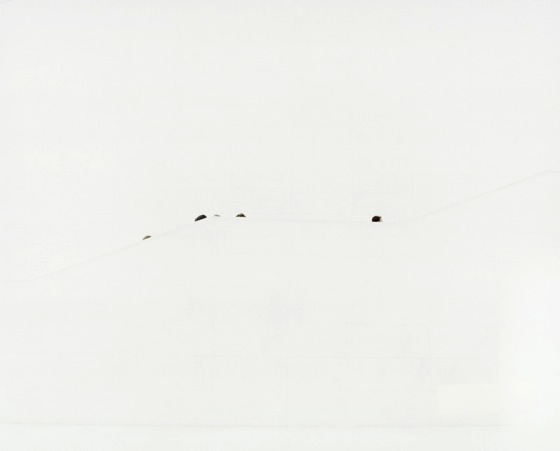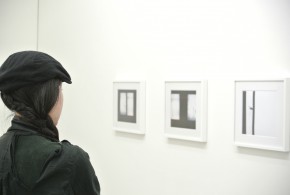Maiko Haruki is a promising artist who experiments with films to achieve new expressions in photography. She intentionally creates under or over exposed images, which makes the photographs almost all black or white. Even in the darkroom, she moves around the negatives to print the blanks between the negatives and uses as an element of her work. In her latest exhibition at Taro Nasu (Tokyo), Haruki deepened her consideration of the act of seeing to the next level in which she created a gravity-less space where one experiences an almost floating sensation. She talked about how she came up with her new works and developed her ideas.

Photographer Maiko Haruki in front of her work
Moving around the negatives in the darkroom
- Let me ask about your new works. I think this is the most mysterious series in your works. How did you create it?
I’m pleased to hear that. Some of the works are printed from a single negative while others are printed by sliding the negatives (in the darkroom). I usually set the right angle to capture the image but this time, I shot very randomly to experiment the different angles, like positioning the camera vertically and crouching into a position to get lower angle.
- It gives us a sense of floating as if I’m seeing from above. Did you shoot from a high angle?
Yes, I did. Actually, in the exhibition room of National Museum of Nature and Science (Tokyo), a part of the floor was glazed. I could look at the mounted animals from above.

Exhibition view of Maiko Haruki “a certain composition of eyes” at TARO NASU.
© Maiko Haruki Courtesy of TARO NASU, Photo by Keizo KIOKU
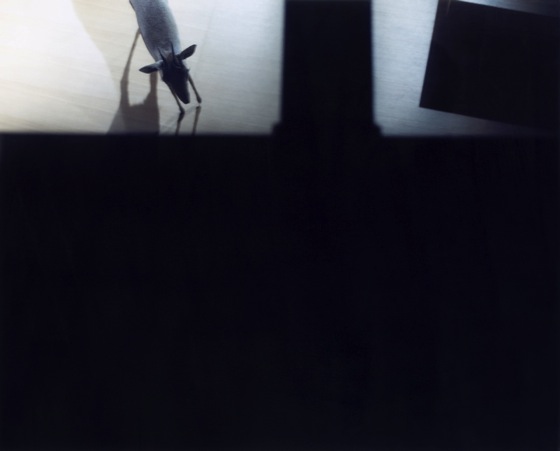
Maiko Haruki “A certain composition of eyes 04″ (2014), Courtesy of TARO NASU
- What are these black parts (upper right of the image above)?
That’s a display case. The light hitting the edge of the case created shadows. I intended to show things mysteriously as you can’t see what it actually is.
- Do you recompose the negatives when you print?
I don’t cut or paste parts of the negatives but I move them around and choose which part to be printed on a sheet. The work images are originally from the negatives lined up next to each other. In “View for a moment” (2011), I did plan out a lot, but this time, I took the photos without thinking. Even if I randomly position the camera, it could be recomposed in the printing process. Even if you look from this or that way, all the randomness suddenly comes to life and looks like an opened-up cube.
- When you are taking photos, do you precisely think about what was captured within the photograph?
For this work, I was not really consciously thinking about it. Only in the “View for a moment” series, I really planned and did a lot of test printings.
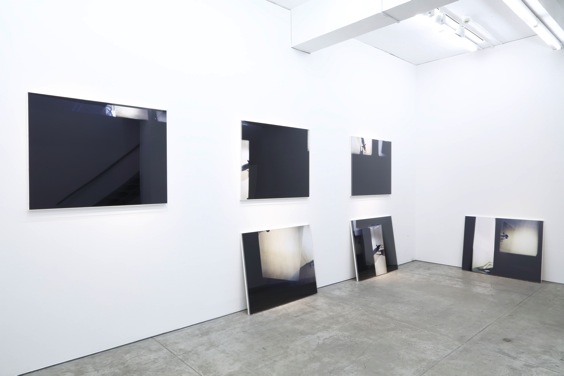
Exhibition view of Maiko Haruki”a certain composition of eyes” at TARO NASU.
© Maiko Haruki Courtesy of TARO NASU Photo by Keizo KIOKU
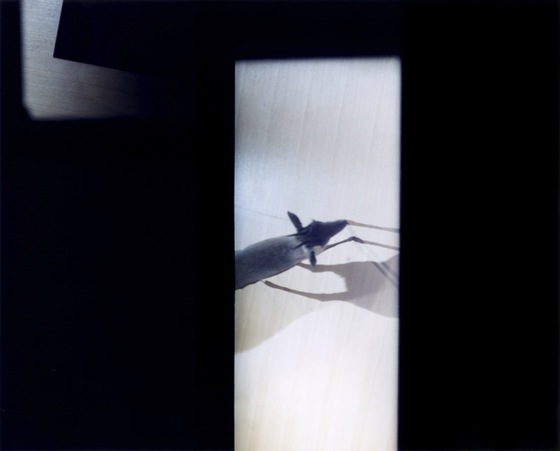
Maiko Haruki “A certain composition of eyes 05″ (2014), Courtesy of TARO NASU
‘Look’ can be understood in many different ways
- Does the exhibition title “A certain composition of eyes” represent your ideas on how to see motifs?
Yes, I think so. In addition to that, it’s also including the idea of perspectives or seeing things. I want people to think about what ‘look’ actually means, which was my starting point. ‘Look’ can be understood in many different ways such as observe, view or regard. Since I couldn’t express it well in words, I used photographs to show it.
- I was surprise to see how you used the gallery’s space.
Up until now, I’ve been a bit afraid of things like installations. I never tried to lean my works against the wall like this. But this time, I wanted to show my works as an “object”. This was the idea I had when I was setting up the prints for this series.

Exhibition view of Maiko Haruki “a certain composition of eyes” at TARO NASU.
© Maiko Haruki Courtesy of TARO NASU Photo by Keizo KIOKU

Exhibition view of Maiko Haruki “a certain composition of eyes” at TARO NASU.
© Maiko Haruki Courtesy of TARO NASU Photo by Keizo KIOKU
This is the first time that I’ve created anything like this. The beauty of mounted animals inspired me. I ended up focusing on one main theme and pursuing it. This work (“trekking 01″) was born out of thinking about looking at things and eliminating any definitions.
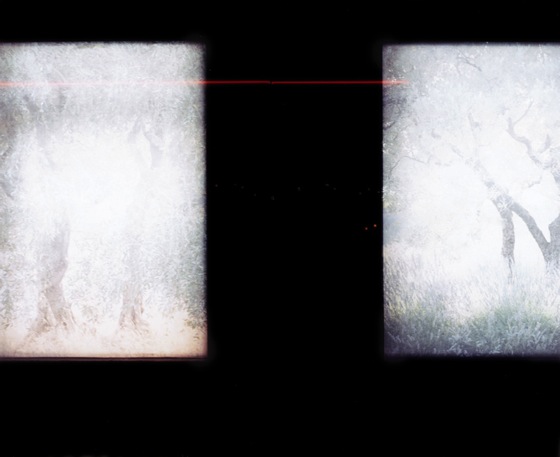
Maiko Haruki “trekking 01″ (2013), Courtesy of TARO NASU
Before planning this exhibition, I created the “portrait” series (2009-2011) and I felt they had no depth in terms of interpretation. No matter how many works that I lined up on a wall, there wasn’t a room for the viewers to use their own imaginations. I thought that I might have controlled too much or insisted too much on my own point of view. It turned out to be boring for me. So I decided to create a work without controlling it. I start to think of how the viewers can truly look at my works freely. I started to break my rules or limitations and started to think outside of the box.
Even if I try to control it totally, it photographs the moment that I couldn’t imagine.
- Was it uncomfortable to control the process?
Yes. I have had a sense of discomfort of my control. However, I found my discomfort was insisting the definition or concept of my work too much, rather than my creating process. I felt it was intrusive to force my concept on the viewers.
- Asking about “View for a moment” (image below) again, you printed two negatives next to each other in one print. What is unique is that you printed the part between the negatives right in the middle of the work as a black bold line. Surprisingly, it looks as if it is precisely hiding a human’s body. How did this work come to be?
Originally, it began with my question on “what a decisive moment is for photography?” I thought over a number of different techniques to print the moments over a brief time period. I wanted to inspire the viewer to imagine what happened before and after the moment. To photograph this work, I timed when the first person walked in the frame and until the next one passed and mentioned the duration time in the title..

Maiko Haruki “318 seconds, from the series ‘view for a moment'” (2011), Courtesy of TARO NASU

Maiko Haruki “51 seconds, from the series ‘view for a moment” ” (2011), Courtesy of TARO NASU
In truth, even if I try to aim for perfection, I can’t. My camera’s vision rate isn’t 100%. I mean what’s actually printed on the film becomes larger than what I see with my camera frame. If I hit the shutter when someone walks in my finder, it’s too late. To capture without peering at the finder, I tested when to hit the shutter by seeing when a person came across a certain point with my bare eyes. Even if I try to control it totally, it photographs the moment that I couldn’t imagine. That’s what makes it most interesting.
-Where did you take this series?
Firstly, I thought that the wall has to be white when I was planning about this work in Japan. And then, I recalled there were some white walls in Paris. I went there for location scouting and found several places. Distances and time of people passing by fit perfectly in that location.

Maiko Haruki “inner portrait I-1M” (2011), Courtesy of TARO NASU
Show a person’s inner self in a photograph
- Speaking of timing, you also used a slow shutter speed in the “Inner Portrait”(image above).
That series was all taken in the same one-second shutter speed. While I was working on “View for a moment”, I wondered what would happen if I apply the same shutter speed to all photos. With a one-second shutter speed, only human’s legs were shown and above that appeared blurry. I wondered whether I can really show a person’s inner self in a photograph. So I chose to use the word “inner”.
- You wanted to make human’s inner personality visible?
Yes. But not with their faces. With their taste in shoes, their speed of walking that is individual to each person. Their speed also changes the blur in photographs. I took this series in four cities. The tendencies and peculiarities that people have, changed with each city.
- The works are in simple forms with little anonymousness.
I showed a bit of characters of each location that can be perceived from the ground captured in my work. The viewer may wonder whether it is taken in Europe or Africa.
- You went to Africa to shoot this?!
Yes, I went to Tunisia. I decided to go there, as I wanted to take photos safely in Africa, and came up with Tunisia.
- Can you tell us about “Outer Portrait”?
I captured the outside of human beings in that series. I was interested in different hair colours etc. The idea arose when I was in the British Museum. The white walls were quite beautiful and I got inspiration from that.
The dense mixture of all colours creates the black
- How would you define portraits?
I’m not sure whether I completely understand what portrait is. I was a kind of scared to approach people. However, I can’t control them and that is the interesting part of portrait. Since it is difficult to control others, I can get an unpredicted result that turns out to be greater than I imagined.
- Within your work, the black colour leaves a strong impression. How do you see the black?
Black isn’t just the absence of light. The dense mixture of all colours creates the black. That’s my understanding on black. In some of my work, the black is from the dense yellow colour of stones.

“okinawa 11″ 2012, C print mounted on Alpolic, H10xW12in (image size), ed.10.

“clearsky” 2006, C print mounted on Alpolic, H10xW12in (image size), ed.10.
Shadow the characteristics of each motif
- What were your works like in your early days?
I used to shoot in black and white but beside that, my works haven’t changes much from my early days. It was more abstract. It was hard to figure out what was shot in the photograph. I really wanted to shadow the characteristics of each motif. I intended to show them mysteriously.
-What brought you to start working in colors?
In black and white, my work was rather far from the reality. I thought that if I capture them in color, I can probably get more close to materiality. Before I use the color films, I tried to create colors using black and white films. I could create my own color with this method. By slightly adjusting the amount of cyan and magenta, I could create my own color. But as the film is for black and white, I couldn’t produce the whole scale of colors.
- From your early stage and until now, you are shadowing the explicit characteristics of each motif in your work. Why is that?
Every object has a name and so do the people. What I’m trying to propose is the way to look at our world without any name or definitions. See things as you actually feel. I’m here to say let’s doubt when we see things!
I always felt uncomfortable to be taken photographs of
- You are proposing the way to see things through your work.
I really like the story of “an anaconda and a hat” in the book “Little Prince” by Sanint-Exupery. In that story, the little prince shows his drawing to grown ups to scare them. However, they weren’t scared since they saw it as a drawing of a hat. But it’s not. Actually, he drew an elephant swallowed by an anaconda. They didn’t see it in that way.
- Even seeing the same thing doesn’t necessarily means they are seeing in the same way. Have you tried other medias before starting photography?
No I haven’t. I had never thought about creating an artwork and showing it to somebody. I rather wanted to work between the audience and the artist. I actually took a curatorial course for my degree.
-Have you always been interested in photography since you were a child?
I always felt uncomfortable to be taken photographs of. My back is seen in many of my family albums since I ran away to escape from being shot. Also, one thing I remember about my childhood is that when we went for a school-hiking trip, we could select some favorite photos (taken by a photographer so that the students can purchase afterwards). While usual students choose the ones they are captured in, I tend to select the photographs of landscapes or colored mountains and never wanted the ones including me.

- So, what made you become photographer?
It’s not simple story but rather a bit complicated. When I failed for a job-hunting, my mother reminded me that I liked photographs. I majored photography when I joined an exchange program to study abroad at my university and she remembered it well.
Then, I started to work in a photography studio to make a living. I was an assistant of a fashion photographer. However, I had a feeling that this is not what I wanted to do. And that emotion moved me to create my own work, with which I got selected for an exhibition (“the 4th contest for the best contemporary artwork, 2000 “). That was my starting point.
-You came so far from then. Congratulations for the new exhibition.
Interviewed by Miho Odaka on Oct 23, 2014.
Exhibition info
Title: a certain composition of eyes
Date: October 10 – November 8, 2014
Place: TARO NASU GALLERY, Tokyo.
Website: http://www.taronasugallery.com/exh/exh_119_e.html


